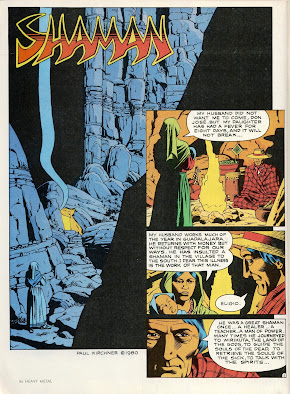‘Flashing Swords ! # 2’ (268 pp.) was edited by Lin Carter and published by Dell in 1974; the cover illustration is by Frank Frazetta.
The 'Flashing Swords' series was designed to showcase all-new short stories and novelettes of heroic fantasy, authored by prominent practitioners of the genre - who happened to be held in high regard by editor Carter, of course.
The anthology opens with ‘The Rug and the Bull’ by L. Sprague de Camp; set in Camp’s ‘Pusad’ universe of ancient Atlantis, it deals with the amiable mage Gezun and his plans to earn a living by marketing magic carpets. The narrative’s tone is light and humorous; however, de Camp’s contrived and cutesy dialogue (be prepared to encounter ‘methinks’, ‘forsooth’ and ‘ensorcellment’, among other terms) lays on too much treacle.
Michael Moorcock contributes an Elric tale, ‘The Jade Man’s Eyes’. Elric and Moonglum accompany the adventurer Duke Avan to the lost city of R’lin K’ren A’a, where treasure awaits, and perhaps clues to the origin of the Menibonean race. With a downbeat atmosphere and ending, this is one of the better of the early Elric stories.
Andre Norton contributes a lengthy ‘Witchworld’ story, ‘Toads of Grimmerdale’. Hertha, a young woman made outcast from her village of Trewsdale, seeks revenge on the soldier of fortune who assaulted her. She enters into a bargain with the otherworldly creatures who lurk at the circle of stones in Grimmerdale; but like many bargains with the Dark Side of the Force, this one, too, has its catch…. I found this story to be a bit too deliberate and slow-paced for my liking, but fans of Norton’s fiction may find it appealing.
John Jakes provides a 'Brak the Barbarian' tale with ‘Ghoul’s Garden’. While traveling through a lonely wood, Brak rescues an actress and a querulous priest from certain death. As the trio resumes their journey it becomes clear that the actress has a troubling secret. Atmospheric, and featuring a creepy villain and unusual magic, this is one of the better Brak tales.
All in all, ‘Flashing Swords ! #2’ is not the most memorable of these anthologies. I came away from reading it with the feeling that, once the mid-70s had been reached, more than a few of the writers in Lin Carter’s circle were rather played out creatively. When it came time to contribute something to his story collections, their submissions were workmanlike, but not all that inspiring.
Unless you are determined to collect every volume in the ‘Flashing Swords !’ series, this one can be passed over.



























































